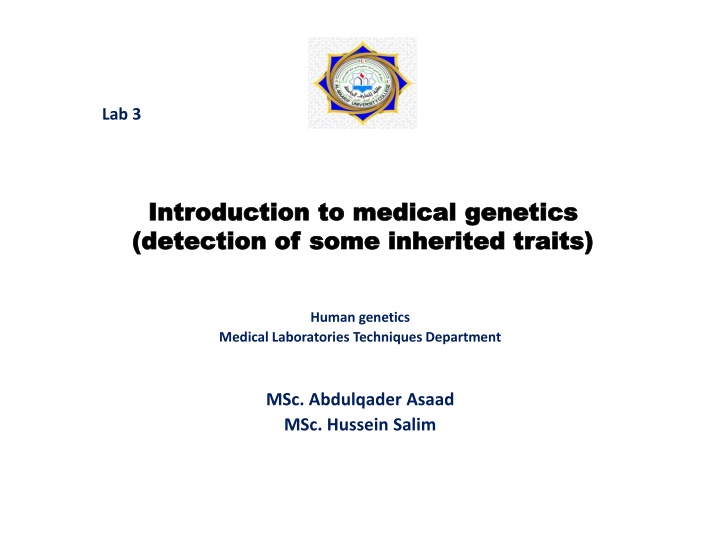
Human Genetics: Traits, Alleles, and Inheritance Patterns
Explore the fundamentals of human genetics including chromosomes, genes, alleles, dominant/recessive traits, incomplete dominance, and codominance. Gain insights into how genetic traits are inherited and expressed in individuals.
Download Presentation

Please find below an Image/Link to download the presentation.
The content on the website is provided AS IS for your information and personal use only. It may not be sold, licensed, or shared on other websites without obtaining consent from the author. If you encounter any issues during the download, it is possible that the publisher has removed the file from their server.
You are allowed to download the files provided on this website for personal or commercial use, subject to the condition that they are used lawfully. All files are the property of their respective owners.
The content on the website is provided AS IS for your information and personal use only. It may not be sold, licensed, or shared on other websites without obtaining consent from the author.
E N D
Presentation Transcript
Lab 3 Introduction to medical genetics Introduction to medical genetics ( (detection of some inherited traits) detection of some inherited traits) Human genetics Medical Laboratories Techniques Department MSc. Abdulqader Asaad MSc. Hussein Salim
The human genome consists of 23 pairs of chromosomes (22 pairs of homologous chromosomes and one pair of sex chromosomes) the set of chromosomes is called the karyotype. In humans there are 23 pairs of chromosomes. The reason the chromosomes are in pairs is because one set of chromosomes comes from the female parent via the egg and the other set of chromosomes comes from the male parent by way of the sperm. During fertilization when the sperm cell fuses with the egg cell the resulting cell is called a zygote and contains two sets of chromosomes.
Gene: A unit of heredity that controls the development of one trait Made of DNA. Allele: Member of a paired gene -one allele comes from each parents Represented by a single letter
each person has two alleles for each gene, one from each parent
Dominant & Recessive Alleles Dominant alleles are expressed Recessive alleles are not expressed in the presence of a dominant allele - Recessive alleles are only expressed if both recessive alleles are present
Incomplete dominance Incomplete dominance is a pattern of inheritance in which neither allele is completely dominant over the other, resulting in an intermediate phenotype. This means that the phenotype of a heterozygous individual is different from both the homozygous dominant and homozygous recessive individuals.
Codominane Codominance is another pattern of inheritance in which both alleles are expressed equally in the phenotype of a heterozygous individual. This means that both traits associated with the alleles are observed in the individual.
Homozygous Both alleles alike AA or aa Heterozygous Alleles are different Aa
Genotype Genetic make up Represented by alleles DD & Dd are genotypes for dwarfism Phenotype A trait Genotype determines the phenotype Dwarfism is a phenotype
Karyotype A karyotype is a visual representation of the number and structure of all the chromosomes
Mutation Change in a gene or chromosome Causes an abnormal traits Mutagen Agent that causes mutation (smoking, pesticides, X ray, Nuclear radiation)
Autosomes (chromosome 1-22) Sex chromosomes (chromosome 23) - male (XY) gametes have either X and Y - female(XX) gametes have X
